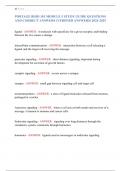Biod 101 module 5 - Study guides, Class notes & Summaries
Looking for the best study guides, study notes and summaries about Biod 101 module 5? On this page you'll find 71 study documents about Biod 101 module 5.
Page 4 out of 71 results
Sort by
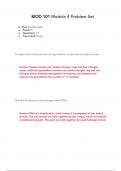
-
BIOD 101 Module 4 Exam Portage learning
- Exam (elaborations) • 11 pages • 2023
- Available in package deal
-
- $12.99
- + learn more
BIOD 101 Module 4 Problem Set ● Due No due date ● Points 5 ● Questions 21 ● Time Limit None Compare and contrast purines and pyrimidines and provide examples of each. Answer: Purines contain two carbon-nitrogen rings and four nitrogen atoms, while the pyrimidines contain one carbon-nitrogen ring and two nitrogen atoms. Adenine and guanine are purines, and thymine and cytosine are pyrimidines (See section 4.1 in module). Describe the structure and arrangement of DNA. Answer: DN...
5 BIOD 101 Module 5 Exam - Portage Learning 5 BIOD 101 Module 5 Exam - Portage Learning 5 BIOD 101 Module 5 Exam - Portage Learning
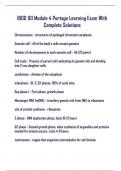
-
BIOD 101 Module 4 Portage Learning Exam With Complete Solutions
- Exam (elaborations) • 10 pages • 2024
- Available in package deal
-
- $21.29
- + learn more
BIOD 101 Module 4 Portage Learning Exam With Complete Solutions Chromosomes - structures of packaged chromatin complexes Somatic cell - All of the body's cells except gametes Number of chromosomes in each somatic cell - 46 (23 pairs) Cell cycle - Process of parent cell replicating its genetic info and dividing into 2 new daughter cells cytokinesis - division of the cytoplasm interphase - G1, S, G2 phases. 90% of cycle time. Gap phase 1 - First phase, growth phase Messenger RNA (mR...

-
BIOD 101 MODULE 6 PORTAGE LEARNING QUESTIONS WITH 100% CORRECT ANSWERS
- Exam (elaborations) • 9 pages • 2023
-
- $9.69
- + learn more
BIOD 101 MODULE 6 PORTAGE LEARNING QUESTIONS WITH 100% CORRECT ANSWERS Module 6 Problem Set ● Due No due date ● Points 5 ● Questions 16 ● Time Limit None Discuss the difference in how prokaryotic and eukaryotic cells store their genetic material. Answer: Eukaryotic cells store their DNA in a membrane bound nucleus, while prokaryotic cells store their DNA in a nucleoid region which is not membrane-bound. (See section 6.1 in the module)
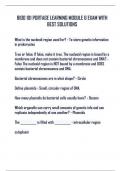
-
BIOD 101 PORTAGE LEARNING MODULE 6 EXAM WITH BEST SOLUTIONS
- Exam (elaborations) • 20 pages • 2024
- Available in package deal
-
- $20.49
- + learn more
BIOD 101 PORTAGE LEARNING MODULE 6 EXAM WITH BEST SOLUTIONS What is the nucleoid region used for? - To store genetic information in prokaryotes True or false: If false, make it true. The nucleoid region is bound by a membrane and does not contain bacterial chromosomes and DNA? - False The nucleoid region is NOT bound by a membrane and DOES contain bacterial chromosomes and DNA. Bacterial chromosomes are in what shape? - Circle Define plasmids - Small, circular region of DNA. How ...
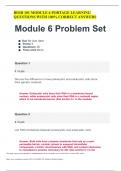
-
BIOD 101 MODULE 6 PORTAGE LEARNING QUESTIONS WITH 100% CORRECT ANSWERS
- Exam (elaborations) • 9 pages • 2023
-
- $8.99
- + learn more
BIOD 101 MODULE 6 PORTAGE LEARNING QUESTIONS WITH 100% CORRECT ANSWERS Module 6 Problem Set ● Due No due date ● Points 5 ● Questions 16 ● Time Limit None Discuss the difference in how prokaryotic and eukaryotic cells store their genetic material. Answer: Eukaryotic cells store their DNA in a membrane bound nucleus, while prokaryotic cells store their DNA in a nucleoid region which is not membrane-bound. (See section 6.1 in the module) List TWO simi...

-
BIOD 101 Module 4 Exam | Questions with Correct Answers | Professor Verified | Graded A+
- Exam (elaborations) • 12 pages • 2023
-
- $16.49
- + learn more
BIOD 101 Module 4 Exam | Questions with Correct Answers | Professor Verified | Graded A+ Compare and contrast purines and pyrimidines and provide examples of each. Answer: Purines contain two carbon-nitrogen rings and four nitrogen atoms, while the pyrimidines contain one carbon-nitrogen ring and two nitrogen atoms. Adenine and guanine are purines, and thymine and cytosine are pyrimidines (See section 4.1 in module). Describe the structure and arrangement of DNA. Answer: DNA is a double h...
PORTAGE BIOD 101 MODULE 5 STUDY GUIDE QUESTIONS AND CORRECT ANSWERS (VERIFIED ANSWERS)
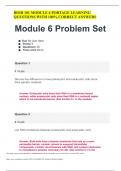
-
BIOD 101 MODULE 6 PORTAGE LEARNING QUESTIONS WITH 100% CORRECT ANSWERS
- Exam (elaborations) • 9 pages • 2023
-
- $8.99
- + learn more
BIOD 101 MODULE 6 PORTAGE LEARNING QUESTIONS WITH 100% CORRECT ANSWERS Module 6 Problem Set ● Due No due date ● Points 5 ● Questions 16 ● Time Limit None Discuss the difference in how prokaryotic and eukaryotic cells store their genetic material. Answer: Eukaryotic cells store their DNA in a membrane bound nucleus, while prokaryotic cells store their DNA in a nucleoid region which is not membrane-bound. (See section 6.1 in the module) List TWO simi...
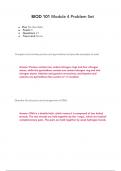
-
BIOD 101 Module 4 Problem Set
- Exam (elaborations) • 11 pages • 2023
-
- $11.99
- + learn more
BIOD 101 Module 4 Problem Set ● Due No due date ● Points 5 ● Questions 21 ● Time Limit None Compare and contrast purines and pyrimidines and provide examples of each. Answer: Purines contain two carbon-nitrogen rings and four nitrogen atoms, while the pyrimidines contain one carbon-nitrogen ring and two nitrogen atoms. Adenine and guanine are purines, and thymine and cytosine are pyrimidines (See section 4.1 in module). Describe the structure and arrangement of DNA. Answer: DN...

That summary you just bought made someone very happy. Also get paid weekly? Sell your study resources on Stuvia! Discover all about earning on Stuvia




